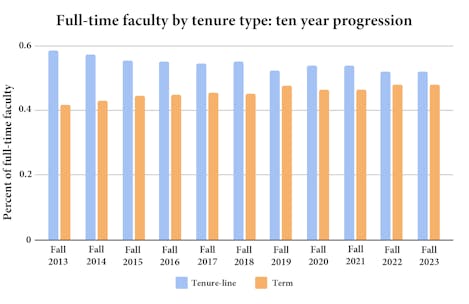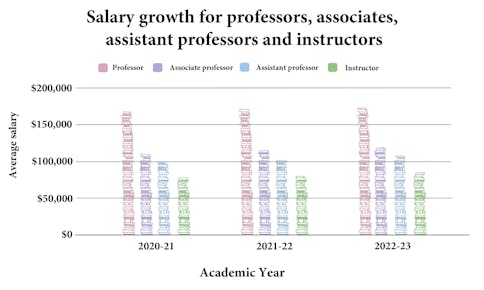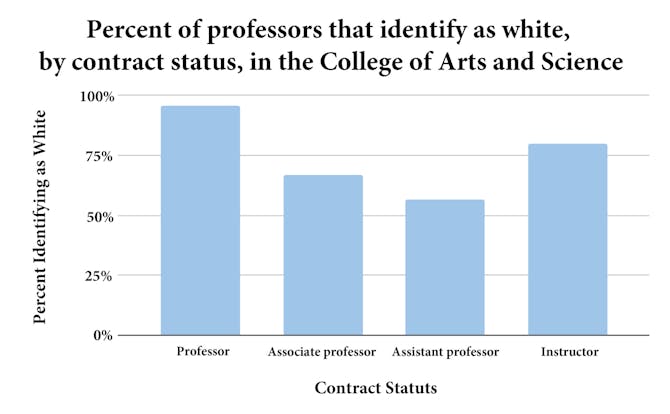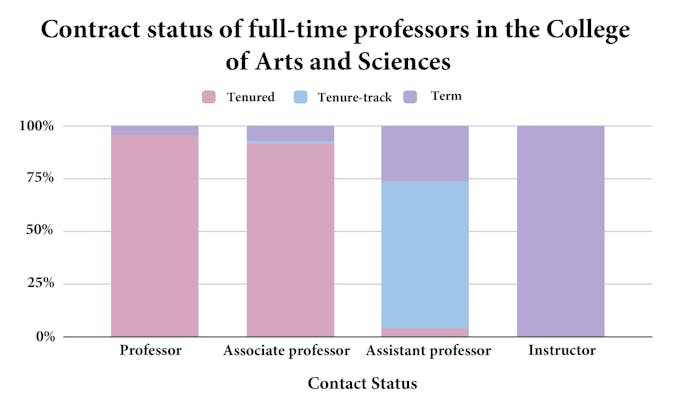From the Newsstands: This story appeared in our December 2023 print edition. You can find the digital version here.
Universities across the country are trending towards hiring term faculty, whose contracts renew frequently. This means that more full-time faculty members face frequent job insecurity and salary disparities — American University is no exception.
Term faculty are faculty with contingent appointments, meaning they have to renew their contracts regularly, initially on a yearly basis. U.S.-based institutions “heavily rely” on such faculty, according to a report by the American Association of University Professors. Term faculty hiring differs from the tenure track, which has been the precedent in academia.
Tenure is a long-debated hallmark of higher education, designed to protect academic freedom and “attract talented individuals to a secure life” in their chosen profession, according to the American University faculty manual. Tenured faculty “provide scholarship, service, and two semesters or their equivalent of full-time teaching,” according to the faculty manual. Tenured faculty do not face regular contract renewal and their jobs are protected from budget cuts. Tenure’s purpose is clear, but this still begs the question — what is the term faculty position designed for?
AU introduced the term faculty position as it is now in 2009, according to Jasmine Pelaez, internal communications manager for the University. AAUP data shows a 21 percent increase in these appointments nationally from 1987 to 2021. In the same period, the amount of tenured and tenure-track faculty saw a 21 percent decline. The University has followed this trend over the last 10 years, with over a six percent increase in term faculty hires from fall 2013 to fall 2023. Meanwhile, the proportion of tenure-line faculty has decreased by the same amount in the same period.

As of fall 2023, 48 percent of the University’s full-time teaching faculty are term faculty, according to Pelaez. This does not necessarily mean that term faculty are teaching 48 percent of classes since, according to Pelaez, in the 2022-23 academic year, 39.5 percent of courses were taught by adjuncts who are mostly part-time faculty.
In the College of Arts and Sciences, term faculty members earn significantly less than tenure-track and tenured faculty, according to a March letter from the CAS Term Faculty Committee to the College’s dean, despite both “providing equal contributions to CAS and AU.”
The letter analyzes data from AU’s 2021-22 Academic Data Reference Book and a March 2022 CAS Term Faculty Committee survey, which had a 72 percent response rate.
As term faculty members take on more roles at the University, some have pointed out that tenure and tenure-track faculty have more benefits than term faculty through sabbatical and research opportunities.
“Adjuncts and terms have been historically disempowered, right? And it’s given the administration a lot more power,” Martyn Oliver, a term faculty member in CAS, said. “Tenure-track folk might not like to admit it, but they were, at least initially, the beneficiaries of the move to term-heavy appointments,” because they could get more “research leaves and reduce their teaching levels in order to focus on their research.”
The reduction in teaching obligation, Oliver said, is good for tenure and tenure-track faculty and for the University because serious research elevates the school’s profile. However, he said, this has an “unanticipated cost.”
“It has undermined the power of faculty at the University on the whole,” Oliver said. “I think tenure-track faculty are only now just waking up to the fact that the bargain for hiring more term faculty and relieving them of teaching burdens has eroded their power.”
What does being a term faculty member mean?
According to the University’s faculty manual, continuing appointment — a newer position at AU in which term faculty are no longer subject to reappointment — and term faculty should be rehired contingent on relevant qualifications, satisfactory performance, budgetary limitations, enrollments and other needs of their department.
For their first three years at the University, a term faculty member must renew their job on a one-year term basis. After that, reappointments are for three-year terms, but departments can still recommend one-year appointments, according to the faculty manual.
“Term faculty contracts range from one to five years and can be renewed, where tenure-track contracts include two three-year contracts for faculty seeking tenure; and tenure contracts are indefinite and tenured faculty undergo rigorous reviews of teaching, research, and service,” Pelaez wrote in a statement to The Eagle.
When faculty members are terminated for budgetary limitations, tenure faculty take priority over continuing appointment status faculty and continuing appointment status faculty take priority over term faculty members, according to the faculty manual. The term faculty promotion sequence progresses from assistant professor to associate professor to professor. The term professorial lecturer promotion sequence is instructor, professorial lecturer, senior professorial lecturer and Hurst senior professorial lecturer.
In the 2022-23 school year, full-time professors at AU made an average salary of $174,374, according to the Academic Data Reference book. Full-time associate professors made an average of $118,337. These are the two positions where faculty are most likely to hold tenure, according to The Eagle’s analysis. For full-time assistant professors, the average salary is $107,989 and for full-time instructors it is $82,940.
What is the University doing for term faculty?
AU introduced the continuing appointment position process in August 2022 and aims to have over 50 percent of term faculty on multi-year contracts. Both of these moves work to mitigate the issues term faculty face.
The University proposed continuing appointment after the Faculty Senate-Provost’s Office task force proposed recommendations to streamline the contract renewal process that is, “widely understood to be burdensome and inefficient for our faculty and for the faculty affairs staff in our schools and colleges,” according to an August 2022 memorandum from the Office of the Provost.
In a June 2023 memorandum, the Office of the Provost updated the community on the ongoing implementation of continuing appointment, under which “eligible term faculty members will apply for continuing appointment in their sixth year of service.” Faculty with continuing appointment status are not subject to the reappointment process but can still be terminated for unsatisfactory performance, misconduct, budgetary limitations, enrollments and other needs of the teaching or academic unit.
“Very few universities have this classification, which will allow non-tenured/tenure-track faculty to avoid undergoing a repetitive reappointment process,” Pelaez wrote in a statement to The Eagle.
In the annual faculty data presentation at an Oct. 4 Faculty Senate meeting, Deputy Provost and Dean of Faculty Monica Jackson reported that progress has been made toward the University’s goal to have over 50 percent of term faculty in each school on multi-year contracts rather than single-year.
“They have taken some steps to provide more job security to term faculty members,” Eileen Findlay, a tenured professor and chair of the Department of Critical Race, Gender, and Culture Studies, said. “They’ve begun to raise the salaries of incoming term faculty members — they’ve raised the floor of the minimum salary offered to term faculty members pretty substantially actually over the last five years.”
This salary increase has been impactful for term faculty members, as has the introduction of continuing appointments, but finding the money to further decrease the discrepancy between tenured faculty and other faculty positions remains an issue.

“This is quite genuine on the part of the AU administration, the desire to improve the working conditions of term faculty, and it’s tangible,” Max Friedman, a tenured history professor and former interim dean in CAS, said. “It’s not enough, of course, and in that regard, the University faces a real dilemma … to pay employees of the University more, you have to get the money somewhere and a majority of AU’s income comes from tuition. And it’s hard to do tuition increases in an environment in which students and their families are already struggling.”
Some term faculty members are still concerned about the risk they run when they apply for continuing appointments.
“What happens if the University just doesn’t actually honor this sort of understood, implicit commitment to moving people into continuing appointment status?” Findlay asked. “What if they just say, ‘you’re going to be expensive?’”
As the University grows in recognition, some term faculty members are asking how much of that growth is aided by the money the University saves in hiring term faculty instead of granting tenure.
“The economics of this structure make the term position make sense in a budgetary way,” Friedman said. “I think that’s why it’s a national trend.”
This trend, according to Oliver, means that term faculty hold unsecure positions — and tenured faculty benefit with more freedom to focus on research.
“The University’s gotten to grow and grow in prestige, I think on the backs of term faculty,” Oliver said. “It does not behoove a department to move a term faculty member to a tenure-track line. Because why would you pay them more and get less teaching out of them?”
Specifics of the term faculty position
Universities can hire term faculty members to take on more teaching than tenured faculty when they are expected to publish less research. However, Friedman said, this makes it possible for term faculty to take on a greater teaching load while being paid substantially lower salaries.
“The problem is that the reality of the job market is that there are [people with] PhDs out there, who are fantastic scholars and very productive and are working like tenure-line faculty, except that they have [an estimated] 50 percent more of the teaching load,” Friedman said. “And their compensation might be maybe two-thirds of what a tenure-line person at their level would get.”
Rae Jereza previously held a position as a term researcher in the School of Public Affairs but is now an adjunct professorial lecturer in the Anthropology Department. They said the discrepancy in salary demonstrates that universities don’t invest enough of their resources in the teaching environment.
“I think it reflects that the University is not really interested in quality of education and supporting its educators, or ensuring that educators have enough resources and, frankly, the emotional and psychological bandwidth to be doing a good job,” Jereza said.
The CAS Term Faculty Committee letter outlined a number of suggestions on how CAS could minimize the pay disparity between tenure and term faculty going forward. Among their suggestions was a temporary salary freeze for all faculty earning over twice the average CAS term faculty salary, which was $68,495 in 2022, according to the Term Faculty Committee’s analysis.
The letter also proposes that every CAS faculty member receive the same amount of merit increase for the same merit score, regardless of other factors.
“We must stress that neither proposal will be sufficient to solve the existing inequity issue in the long run,” the letter stated. “More progressive solutions will need to be discussed for subsequent salary increases.”
Salary disparities: the College of Arts and Sciences as a case study
The Committee’s letter, which was addressed to the College’s dean, points out that the salary disparity doesn’t account for benefits that tenured faculty members get, such as sabbaticals. The letter also raises concerns that an increasing salary gap between tenure-track and tenured faculty and term faculty threatens the University’s structure.
“The difference in current salaries and benefits is not only inconsistent with AU’s values and ideas but is also a threat to social cohesion across faculty and more generally a threat to AU’s progress, including student retention,” the letter stated.
The data analysis in the letter estimates that the gap between average CAS term and tenure salaries increased from $37,021 in 2012 to $44,728 in 2022 — over a 20 percent increase in 10 years. This analysis is based on information provided in the Chronicle of Higher Education, Academic Data Reference Books and the CAS Term Faculty Survey.
The analysis found that term faculty make, on average, just 60.5 percent of what tenured and tenure-track faculty earn.
After sending the letter, the Committee met in April 2023 with the CAS dean and the CAS associate dean for budget, who did not challenge that the salary difference between tenure and term faculty has been increasing from 2012 to 2022, wrote professor Ben Gunter, chair of the CAS Term Faculty Committee, in an email to The Eagle.
There were salary increases for all staff and faculty in 2022 and 2023, and specific salary increases for term faculty were implemented in September 2022 and September 2023 to counter the increasing salary difference, Gunter wrote, but no sufficient data exists to analyze the salary difference between tenure-line and term faculty since 2022.
In September, Acting Provost and Chief Academic Officer Vicky Wilkins released data on faculty salaries and academic growth, which did not break down tenure-line and term faculty salaries, but did broadly confirm data analysis from the Committee letter.
Job security, power and agency
For some of her colleagues, Findlay said, having a term position makes it difficult to put down roots in the D.C. area. Despite University efforts to create a formalized promotion track for term faculty, she said there still isn’t enough job security.
“How do you even sign a long-term lease somewhere in an apartment building?” Findlay said. “How do you build a life when you don’t know, from one year to the next, you’re gonna have a job?”
Jereza said they faced a number of obstacles when they were not rehired to their term position in SPA. On top of losing their income, they said they found themself in a difficult situation without healthcare coverage.
“When I lost my job — with no warning, by the way — I lost my health care,” they said. “I was actually planning on getting gender-affirming surgery in September, and I didn’t have healthcare to do it. I have multiple mental illness diagnoses. They’re very well managed, but through medication and therapy. And I lost that for a long time.”
Findlay said that she knows some term faculty members in CAS who take on service and administrative responsibilities to obtain longer contracts. The goal, she said, is to make themselves indispensable to the University.
“A lot of term faculty members started agreeing to do major service responsibilities, in addition to teaching a lot more classes than tenure track faculty, in order to get contracts that were multiple years long so that they wouldn't have to be constantly reapplying for their jobs,” Findlay said.
But according to Oliver, holding a term position can also hinder faculty from acting fully in these additional leadership roles. He said that it can be difficult to make decisions in a leadership capacity when dealing with the pressure of contract renewal.
“I need to be the happy soldier so that I can maintain my employment,” Oliver said. “Because if I upset the wrong person, my contract comes up in two years. Tenure resolves that, so it makes for a wonky power balance.”
According to Jereza, concerns about contract renewal can, in some cases, restrain term faculty from voicing their own opinions or facilitating discussions about contentious issues.
“There is a general understanding, and mentors who are more senior academics than you will give you advice that says, ‘Be careful what you say about X and Y and Z political issue,’” Jereza said. “Because if you speak up in certain ways about these issues, then that could jeopardize your ability to get renewed in a job.”
Findlay said she feels that job security is particularly important for University faculty because of the political climate, which she said is becoming increasingly hostile towards educators. Expanding tenure to term faculty would provide protection against retaliation and censorship, she said.
“Academic freedom and intellectual freedom are really at risk,” she said. “It’s under attack in the historical moment that we’re living in and tenure is a very important protection that allows university educators to continue to inquire and to teach students to inquire about all sorts of issues. And I think we should be expanding tenure.”
Lauren Weis, a term faculty member in the Philosophy Department, said that regular position renewals force professors to remain in the job market, which takes time away from their students.
“[People with] PhDs aren’t typically — in the humanities and social sciences — equipped explicitly to navigate the job market outside of academia,” Jereza said. “And so when you have this problem of universities increasingly cutting tenure lines, not renewing them, turning to adjunct and or term faculty, you're leaving people with no choice.”
The obstacles that accompany job insecurity impact people with less stability far more, according to Jereza. People from lower socioeconomic backgrounds, people without a partner to supplement their income and those who are otherwise systemically marginalized are further disadvantaged when faced with periods of sporadic employment.
“That’s how racial capitalism works,” Jereza said. “You have a situation in which there is a drive for more and more and more money-making at the expense of students and the staff, including faculty. Then at the same time, you have this ideological campaign going on that [says] they care about you and they care about faculty of color. And it’s just so transparent that that is actually not the case.”
Reinforcing inequities
Inclusive Excellence, the University’s plan for advancing racial equity, works to improve inclusivity on campus and address systemic barriers, including through hiring practices. Term faculty say that unequal pay prevents that.
“The University strives to maximize the number and percentage of full-time faculty in tenured and
tenure-track appointments consistent with AAUP guidelines,” according to the faculty manual. The majority of tenure and tenure-track full-time professors in CAS are full professors, followed by associate professors and a few assistants.
In CAS, according to the 2022-23 Academic Data Reference Book, around 90 percent of tenure and tenure-track professors were white, around 92 percent of tenure and tenure-track associate professors were white and just over 56 percent of assistant professors were white.

Assistant professors are less likely to be tenured, with just two out of 53 total in CAS holding tenure and 37 on a tenure track. This means that in CAS, the salary gap between tenure and term faculty is compounding a racial and ethnic pay disparity, as, proportionally, more faculty of color are assistant professors than any higher rank.

In May 2023, The Eagle reported that 70 out of 100 new hires identified as people of color. There are 166 total lecturers in CAS, all of whom are term faculty, and fewer than 70 percent of whom are white.
This suggests the University hiring increasing numbers of term faculty compounds the racial and ethnic pay disparity between term and tenure faculty.
In September 2023, the University released data on faculty and administrative growth. The report included average salary breakdowns by position, from instructors and lecturers, to assistant, associate and full professors. The release was meant to, “respond to the data request made to the Provost’s office in Spring 2023 by the Working Group on Faculty Engagement (WGFE).”
The report also included a breakdown of the yearly average earned salary by gender, from 2013-2022, in each faculty rank. The data showed that in 2022, for all faculty ranks besides assistant professors, the mean average salary for male faculty was higher than for female faculty. The data did not include a breakdown of faculty salary data by race despite including headcounts of full-time faculty by rank accounting for race and ethnicity.
Finding solutions to a national issue
While acknowledging that there are few easy answers to this issue, Oliver said that transparency is the first step in starting a dialogue between AU and its faculty.
“The University has worked hard to not release salary data because it would mean recognition of the inequalities in our pay scale,” he said. “It would be free to simply share everybody’s salary data, but everybody’s terrified of that — that somebody’s gonna get mad. But it’s sort of like well, people are already mad. So let’s pull the Band-Aid off and start to actually address it.”
According to Jereza, the crux of the issue is the profit model that shapes universities and other higher education institutions. They said that as long as the primary motivation of schools and universities is profit, there cannot be a solution that creates stability for faculty and students.
“I think to make things better for everyone, we need to get rid of that capitalist logic – the entrepreneurial logic of university and of higher [education],” they said. “If we want things to be better and instead treat universities and colleges as communities of learning, then we have to try to address the deep inequalities that exist within that community.”
This issue isn’t specific to American University — it’s a national trend. But term faculty say AU is still responsible for trying to fix it.
“I think if AU wanted, they can be a true national leader on this,” Oliver said. “But there’s got to be the will, and that will need to come from the administration, but also from the tenured faculty who decide that they want to get behind their colleagues and really push to make it happen.”
This article was edited by Zoë Bell, Tyler Davis, Kate Corliss and Jordan Young. Copy editing done by Isabelle Kravis, Sarah Clayton, Luna Jinks, Charlie Mennuti and Olivia Citarella.





